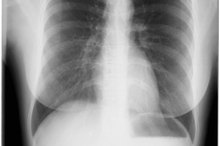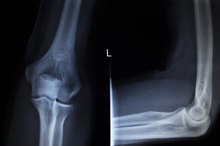What Are the Causes of Burning Neck Pain?
A number of conditions can produce pain in the back of the neck. Depending on the cause and tissues involved, neck pain can feel like a dull, boring, aching, sharp, stabbing or burning sensation. Burning neck pain is often due to stretching or pressure on nerves in the area. Stretching or tearing of neck ligaments and muscles may also cause burning neck pain 5.
If you are experiencing serious medical symptoms, seek emergency treatment immediately.
Nerve Compression
When a disc between two adjacent bones in the spine moves from its normal location, it often presses on nerves in the area. When this occurs in the neck, this condition -- called a herniated or slipped disc -- often produces burning pain in the neck, which may travel to the shoulder and arm. The pain typically increases with moving the head and neck and may be accompanied by numbness, tingling and weakness in the neck, shoulder or arm. A herniated disc in the neck is usually caused by gradual deterioration of the spine with age. Sometimes it is due to a neck injury.
Nerve compression in the neck can also occur for reasons unrelated to discs. Degenerative changes can cause overgrowth of spinal bones, which may press on nerves in the area. Tumors in and around the spinal cord can also compress surrounding nerves.
- When a disc between two adjacent bones in the spine moves from its normal location, it often presses on nerves in the area.
- Degenerative changes can cause overgrowth of spinal bones, which may press on nerves in the area.
Stretched Brachial Plexus
Pinched Shoulder & Nerve Bicep Pain
Learn More
The brachial plexus is a group of nerves that originate in the spinal cord of the neck and travel into the arm. When the brachial plexus is stretched, burning pain occurs in the neck, shoulder and arm. Arm numbness, tingling or weakness may also be present. The brachial plexus is stretched when the head and neck are forced to one side while the opposite shoulder is pushed downward. Brachial plexus stretching injuries -- also known as stingers or burners -- often occur in athletes participating in contact sports such as football, rugby or hockey.
- The brachial plexus is a group of nerves that originate in the spinal cord of the neck and travel into the arm.
- When the brachial plexus is stretched, burning pain occurs in the neck, shoulder and arm.
Neck Strain or Sprain
Strains -- stretching or tearing of muscles -- and sprains -- stretching or tearing of ligaments -- may cause burning neck pain. The pain usually remains in the neck and shoulders and does not travel into the arms. Neck stiffness often accompanies neck strains or sprains, and some people experience headaches as well. Whiplash is a type of neck strain or sprain injury. It is caused by sudden forward and backward movement of the head and neck during a rear-end collision motor vehicle accident.
- Strains -- stretching or tearing of muscles -- and sprains -- stretching or tearing of ligaments -- may cause burning neck pain.
Other Causes
Causes of Pain in the Neck & Back of the Head
Learn More
A variety of other conditions can cause neck pain that may sometimes feel like a burning sensation 4. Most are not serious. However, meningitis -- infection of the tissue surrounding the brain and spinal cord -- is a life-threatening cause of neck pain. The pain typically worsens when bending the head forward. Other meningitis symptoms may include:
- a fever
- rash
- headache
- vomiting
- drowsiness
- confusion
- eye pain due to bright lights
A head injury may also cause neck pain, especially if bleeding occurs within the skull. Drowsiness, confusion and vomiting often occur with a significant head injury. Weakness of the arms or legs, difficulty speaking and changes in vision, hearing or sensation may be present as well.
- A variety of other conditions can cause neck pain that may sometimes feel like a burning sensation 4.
- Drowsiness, confusion and vomiting often occur with a significant head injury.
Seeking Medical Attention
See your doctor if you have persistent or severe burning neck pain. Also see your doctor if you feel generally unwell or have unexplained weight loss, as these may indicate the presence of a tumor. Seek immediate medical attention if your neck pain is accompanied by numbness or weakness in your legs or changes in bowel or bladder function. These symptoms suggest that your spinal cord may be compressed or injured. Also seek immediate medical care if your neck pain was caused by a head injury or if you have symptoms of meningitis.
Reviewed and revised by Mary D. Daley, MD.
- See your doctor if you have persistent or severe burning neck pain.
- Also seek immediate medical care if your neck pain was caused by a head injury or if you have symptoms of meningitis.
Related Articles
References
- Spine Universe: Cervical Sports Injuries: The Stinger
- University of Southern California: Herniated Disc
- American Family Physician: Cervical Radiculopathy: A Common Cause of Neck Pain
- Australian Family Physician: An Approach to Neck Pain for the Family Physician
- American Academy of Orthopedic Surgeons. Cervical Fracture (Broken Neck). Reviewed December 2013.
- Moley PJ. Evaluation of Neck and Back Pain. Merck Manual. Updated August 2019.
- Cleveland Clinic. Think You Might Have Whiplash? Know the Symptoms. Updated January 2, 2017.
- Singh S, Kumar D, Kumar S. Risk factors in cervical spondylosis. J Clin Orthop Trauma. 2014;5(4):221-6. doi:10.1016/j.jcot.2014.07.007
- American Academy of Orthopaedic Surgeons. Cervical spondylosis (Arthritis of the Neck). Updated August 2015.
- ScienceDirect. Discogenic Pain: Treatment of Lumbar Discogenic Pain. 2009.
- Columbia University Department of Neurology. Cervical Spondylosis.
- Touma J, May T, Isaacson AC. Cervical Myofascial Pain. Treasure Island, FL: StatPearls Publishing. Updated September 13, 2019.
- World Health Organization. Spinal Cord Injury. 2013.
- Centers for Disease Control and Prevention. Meningococcal Disease: Signs & Symptoms. Updated June 7, 2017.
- National Institute of Neurological Disorders and Stroke. Meningitis and Encephalitis Fact Sheet. Updated August 13, 2019.
- Stanford Children's Health, Lucile Packard Children's Hospital. Meningitis in Children.
- University of Southern California. Cervical Spine Infections.
- Cleveland Clinic. Salivary Gland Cancer. Updated October 13, 2018.
- Morris NA, Merkler AE, Gialdini G, Kamel H. Timing of incident stroke risk after cervical artery dissection presenting without ischemia. Stroke. 2017;48(3):551-555. doi:10.1161/STROKEAHA.116.015185
- Cleveland Clinic. Cervical (Carotid or Vertebral) Artery Dissection. Updated May 24, 2019.
- Eubanks JD. Cervical radiculopathy: nonoperative management of neck pain and radicular symptoms. Am Fam Physician. 2010;81(1):33-40.
- Khare S, Seth D. Lhermitte's sign: The current status. Ann Indian Acad Neurol. 2015;18(2):154-6. doi:10.4103/0972-2327.150622
- American Academy of Orthopedic Surgeons. Cervical Radiculopathy: Surgical Treatment Options. Updated June 2015.
- American Academy of Orthopedic Surgeons. Cervical Fracture (Broken Neck). Reviewed December 2013.
- Chow AW. (2018). Deep neck space infections in adults. Durand MJ, ed. UpToDate. Waltham, MA: UpToDate Inc.
- Cohen SP. Epidemiology, diagnosis, and treatment of neck pain. Mayo Clinc Proc. 2015 Feb;90(2):284-99. doi:10.1016/j.mayocp.2014.09.008
- Isaac Z, Kelly HR. (2018). Evaluation of the adult patients with neck pain. Atlas SJ, ed. UpToDate. Waltham, MA: UpToDate Inc.
- Martinez-Perez R, Fuentes F, Alemany VS. Subaxial cervical spine injury classification system: is it most appropriate for classifying cervical injury? Neural Regen Res. 2015 Sep;10(9):1416-7. doi:10.4103/1673-5374.165508
Writer Bio
Martin Hughes is a chiropractic physician, health writer and the co-owner of a website devoted to natural footgear. He writes about health, fitness, diet and lifestyle. Hughes earned his Bachelor of Science in kinesiology at the University of Waterloo and his doctoral degree from Western States Chiropractic College in Portland, Ore.








